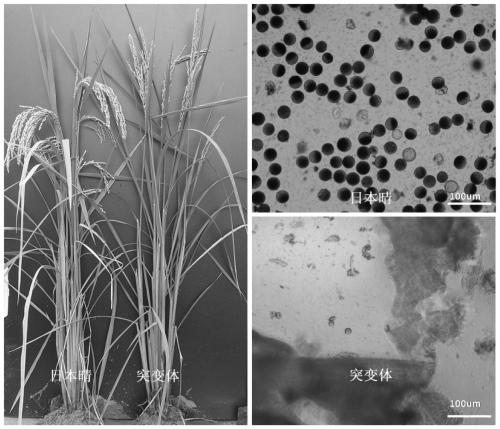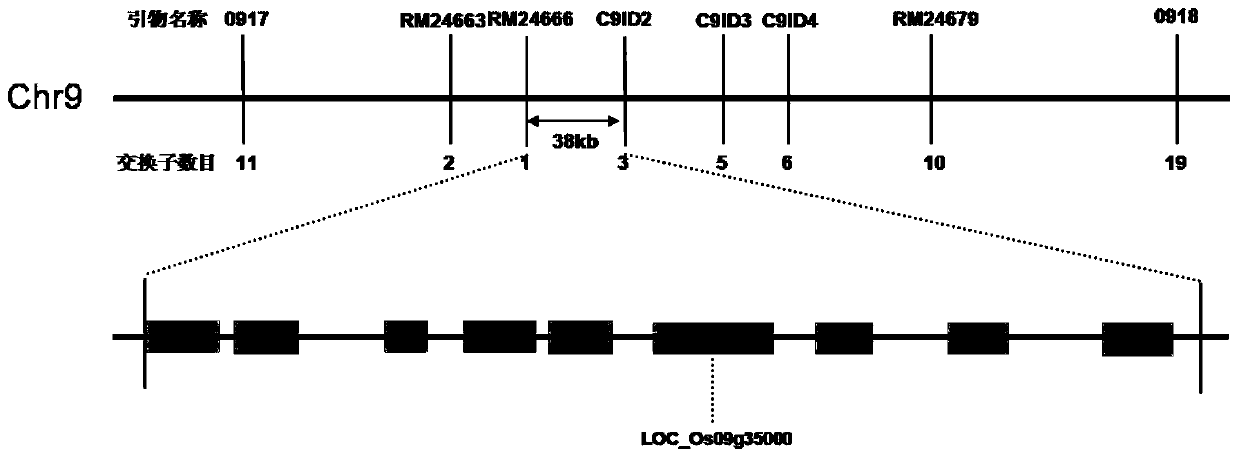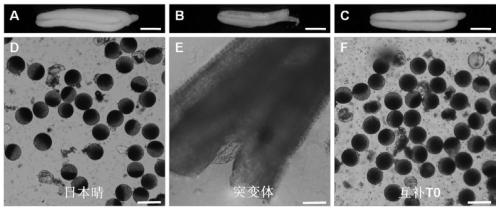A mutant gene of rice nuclease gene osgen-1 and its application
A technology of mutated genes and nucleases, applied in the fields of application, hydrolase, genetic engineering, etc., can solve problems such as difficulty in finding restorer lines, inconsistent fertility of interfering offspring, restrictions on heterosis utilization, etc., and achieves a highly practical effect
- Summary
- Abstract
- Description
- Claims
- Application Information
AI Technical Summary
Problems solved by technology
Method used
Image
Examples
Embodiment 1
[0022] Obtaining and morphological observation of embodiment 1, OsGEN-L mutant plant
[0023] From the winter of 2011 to the spring of 2012, calluses were induced and differentiated into seedlings with the embryos of Japan's sunny dry seeds. After rooting and training, the first-generation seedlings were transplanted to paddy fields for planting. When they matured, they were harvested in a single ear. The second generation was planted in 2013. After flowering The pollen fertility of the second-generation lines was observed in the second generation, and it was found that there were 5 sterile mutants in one line. The anthers of all the sterile plants had no pollen, and they did not self-fertilize when they matured, but after pollination with normal pollen Strong normal ( figure 1 ). Nipponbare and Zhongjiu B (indica rice) were used to cross the mutants with normal fertility and planted F in 2014 1 , found F 1 All fertile, planted F in 2015 2 The segregation ratios of fertil...
Embodiment 2
[0024] Location and cloning of embodiment 2, OsGEN-L gene
[0025] 1. Positioning groups
[0026] With the above sterile mutants, F 2 In order to locate the population, carry out the phenotype identification of individual plants in the field according to the fertility, and take the young leaves of 15 fertile plants for each plant, and take the F 2 The young leaves of all the male sterile plants were used for later use.
[0027] 2. Extraction of rice DNA
[0028] Parents were extracted using the improved CTAB method, including the following steps: Take 0.1-0.2 grams (about half a piece) of leaves and put them in a small mortar, add an appropriate amount of liquid nitrogen, grind them to powder immediately, put them into a 2m1 centrifuge tube, and add 700μL Put the 1.5×CTAB solution preheated at 100°C in a centrifuge tube, mix it carefully, put it in a 65°C water bath, take out the centrifuge tube after 20 minutes, add an equal volume of chloroform / isoamyl alcohol, mix vigoro...
Embodiment 3
[0035] Example 3, Functional Verification of OsGEN-L Gene
[0036] In order to further confirm that the OsGEN-L gene is the gene that causes the phenotype of the male sterile mutant, the OsGEN-L gene and its expression regulatory region (including 3626 bp exons and Contains, 2125bp upstream promoter and 1559bp downstream terminator), the nucleotide sequence is shown in SEQ ID NO.29. The specific operation is segmented amplification and connection into the pCAMBIA1301 vector: using the restriction site BstEII existing in the middle of the coding region, the restriction site BamHI is added to the end of the first half of the upstream primer C360F1, and the first half of the downstream primer C360R1 is located at the BstEII site Finally, the second half of the upstream primer C360F2 is located in front of the BstEII site, and the end of the second half of the downstream primer C360R2 adds a restriction site XbaI. The sequence of the cloning primers is shown in Table 1; first use ...
PUM
 Login to View More
Login to View More Abstract
Description
Claims
Application Information
 Login to View More
Login to View More - R&D
- Intellectual Property
- Life Sciences
- Materials
- Tech Scout
- Unparalleled Data Quality
- Higher Quality Content
- 60% Fewer Hallucinations
Browse by: Latest US Patents, China's latest patents, Technical Efficacy Thesaurus, Application Domain, Technology Topic, Popular Technical Reports.
© 2025 PatSnap. All rights reserved.Legal|Privacy policy|Modern Slavery Act Transparency Statement|Sitemap|About US| Contact US: help@patsnap.com



